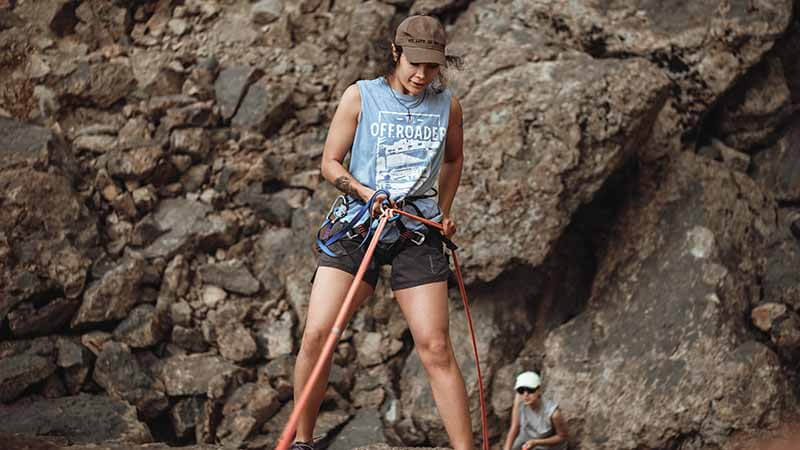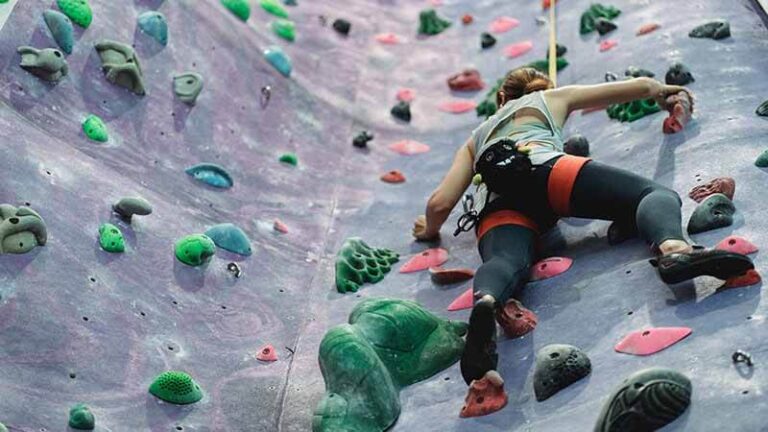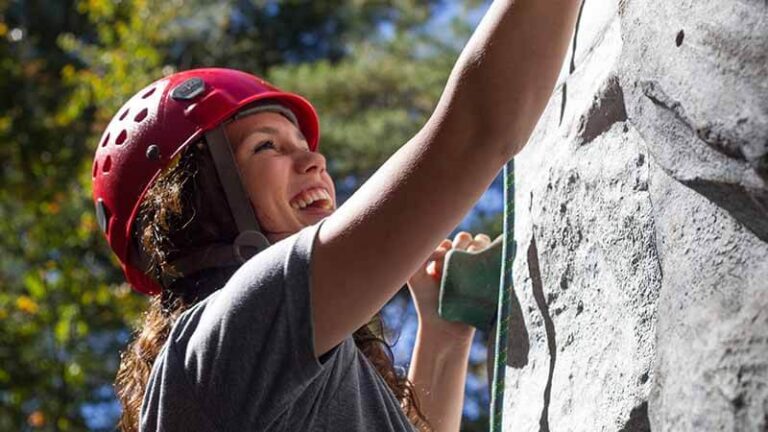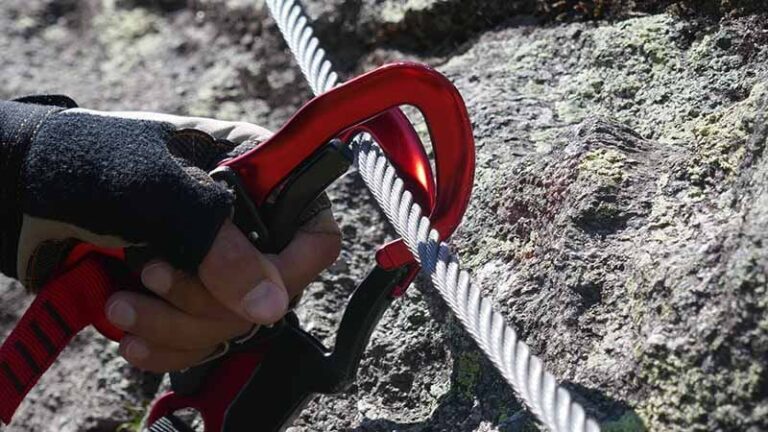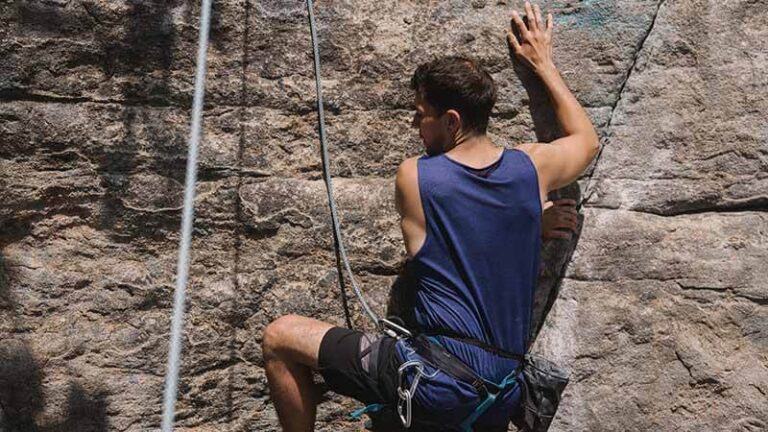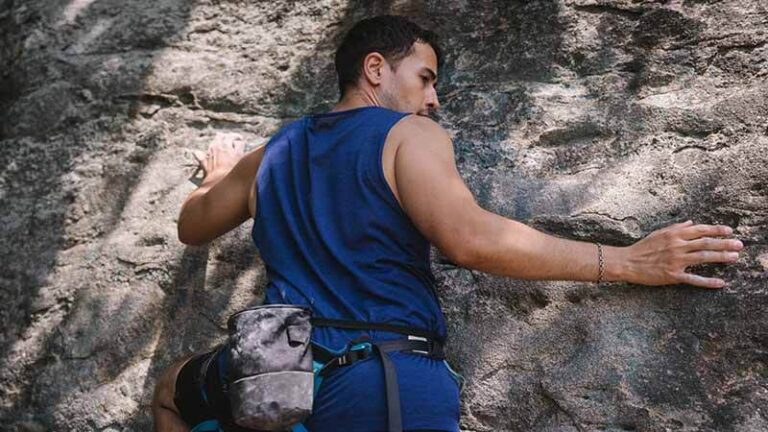Is Rock Climbing Bad for Your Knees?
Rock climbing is an adventure activity that entails scaling natural or man-made rock structures. It is a physically demanding and difficult activity that needs strength, endurance, and technique. Rock climbing can be done both indoors and outdoors, and the difficulty levels can range from basic for beginners to extreme for experienced climbers.
Knowing whether rock climbing is dangerous for knees is critical because knee injuries are one of the most common rock climbing injuries. Because of its complicated anatomy and the amount of force, it endures while climbing, the knee joint is extremely prone to injury. Knee injuries can range in severity from mild sprains to ligament tears or fractures.
Knee injuries are not only unpleasant and incapacitating, but they can also result in long-term problems and chronic pain if not managed. Knee injuries can also impair a person’s ability to accomplish daily tasks and limit participation in physical activities such as rock climbing, lowering their overall quality of life.
As a result, understanding the hazards connected with rock climbing and knee injuries is critical, as is taking preventative measures to limit the possibility of injury. Rock climbing knee injuries can be reduced with proper training, technique, and equipment.
Knowing the most prevalent knee injuries in rock climbing, as well as the factors that enhance the risk of injury and preventative measures can assist climbers in making informed decisions regarding their safety and well-being while engaging in this demanding and rewarding sport.
Anatomy of the Knee
The knee joint is the human body’s largest and most complex joint. It connects the femur (thigh bone) to the tibia (shin bone), including the patella (kneecap) and fibula bone. The knee joint allows for a wide range of movement, including leg bending and straightening, and it plays an important function in supporting the body’s weight and allowing mobility.
Components of the knee joint
The knee joint is composed of four major components:
- Bones: The femur, tibia, fibula, and patella make up the knee joint.
- Cartilage: The knee joint has two types of cartilage: articular cartilage and meniscus. Articular cartilage is a smooth, slippery substance that covers the ends of bones and allows them to glide freely against one another. The meniscus is a segment of cartilage in the shape of a C that acts as a cushion between the femur and the tibia, reducing friction and absorbing shock.
- Ligaments: The anterior cruciate ligament (ACL), posterior cruciate ligament (PCL), medial collateral ligament (MCL), and lateral collateral ligament (LCL) are the four major ligaments of the knee joint. These ligaments aid in the stabilization of the knee joint and the prevention of excessive movement.
- Muscles and Tendons: The muscles and tendons that surround the knee joint are in charge of moving and supporting the joint during exercise.
How the knee joint functions
The knee joint is a hinge joint that allows for leg flexion (bending) and extension (straightening). The ligaments and muscles that surround the knee joint collaborate to stabilize and control movement.
When the knee joint moves, the patella slides down a groove on the femur, assisting in the transfer of quadriceps muscle force to the lower leg. The meniscus is also important for knee joint function, acting as a shock absorber and distributing weight throughout the joint surface.
Common Knee Injuries in Rock Climbing
Rock climbing can be hard on the knees, making them prone to damage. The following are some of the most prevalent knee injuries in rock climbing:
- Patellar Tendinitis: A patellar tendon injury develops when the tendon that links the patella to the tibia becomes inflamed. Overuse and repetitive strain are common causes, and symptoms include soreness and swelling in the front of the knee.
- Meniscal Tears: The meniscus is a piece of cartilage in the shape of a C that functions as a cushion between the femur and tibia. Meniscus tears can occur as a result of an abrupt twisting or bending of the knee, and symptoms include discomfort, swelling, and trouble moving the knee.
- ACL Tears: The ACL, or anterior cruciate ligament, is a vital ligament that aids in the stabilization of the knee joint. ACL tears are frequently caused by a rapid twisting or hyperextension of the knee and can result in considerable pain, edema, and instability.
- MCL/LCL Tears: The MCL (medial collateral ligament) and LCL (lateral collateral ligament) are two ligaments that support the knee joint. Tears in these ligaments can occur as a result of twisting or direct trauma to the knee, resulting in discomfort, edema, and instability of the knee joint.
- Patellar Dislocation: When the patella is moved out of its natural position, it is said to be dislocated. It is caused by a quick twisting or a direct hit to the knee, and it can produce discomfort, edema, and instability in the knee joint.
Causes of knee injuries in rock climbing
Overuse, poor technique, insufficient warm-up or cool-down, and falls or impacts are some of the major causes of knee injuries in rock climbing. Climbers who do not adequately warm up and stretch before climbing, as well as those who employ inappropriate techniques or undertake climbs that are beyond their skill level, may be more prone to knee injuries.
Symptoms of knee injuries in rock climbing
Pain, edema, instability, and trouble moving the knee joint are all symptoms of rock climbing knee injuries. When the injury occurs, there may be a popping or cracking sound or sensation.
Treatment options for knee injuries in rock climbing
Rest, ice, compression, and elevation (RICE), as well as physical therapy, pain management, and, in severe cases, surgery, may be used to treat knee injuries sustained during rock climbing. The type and degree of the damage will determine the best therapy, and climbers should always seek medical assistance if they feel they have experienced a knee injury while climbing.
Factors that Affect the Risk of Knee Injuries in Rock Climbing
Several factors can influence the likelihood of knee injury while rock climbing. Physical considerations, environmental conditions, and other factors such as previous injuries, training regimens, and techniques are examples of these.
Physical Factors
- Age: As we become older, our joints become less flexible and more prone to damage. Climbers over the age of 50 may be more prone to knee injuries than younger climbers.
- Body weight: Excess body weight can place extra strain on the knees, making them more prone to injury. Overweight climbers may be at a higher risk of a knee injury.
- Strength: Strong leg muscles can help support the knee joint and lessen injury risk. Climbers with weaker leg muscles may be more susceptible to a knee injury.
- Flexibility: Allowing the knee joint to move through its entire range of motion will help prevent knee problems. Climbers with less flexibility may be more vulnerable to a knee injury.
Environmental Factors
- Climbing terrain: The type of terrain on which a climber climbs can influence the risk of a knee injury. Climbing on uneven or unstable terrain puts additional strain on the knees, increasing the chance of injury.
- Climbing style: Different climbing approaches necessitate different movements and may place varying demands on the knees. Bouldering, for example, which requires short, strong movements, may place greater pressure on the knees than sport climbing, which requires longer, more controlled motions.
- Climbing equipment: The type of climbing equipment used by a climber can influence the likelihood of knee injuries. Climbers who wear shoes that don’t fit properly or don’t provide enough support are more likely to get knee problems.
Other Factors
- Previous injuries: Climbers who have previously hurt their knees may be more likely to re-injure them. To avoid future damage, it is critical to thoroughly recover from knee injuries before resuming climbing.
- Exercise routine: Exercise can help strengthen the muscles around the knee joint and lower the chance of injury. Climbers who exercise on a regular basis may be less prone to a knee injury.
- Technique: Correct technique can help lessen the likelihood of knee injury. Climbers who utilize appropriate techniques and prevent overuse or bad motions may have a lower risk of a knee injury.
Understanding these characteristics can assist climbers in taking precautions to limit the likelihood of knee injuries during rock climbing. This may involve proper training, the use of appropriate equipment, and the development of good techniques.
Climbers who have previously hurt their knees should take particular precautions to avoid re-injury, and all climbers should seek medical assistance if they believe they have suffered a knee injury while climbing.
Preventing Knee Injuries in Rock Climbing
Rock climbers who wish to stay safe and healthy must avoid knee injuries. Climbers, fortunately, can take numerous precautions to limit the risk of a knee injury while climbing.
- Knee strengthening exercises: Strong leg muscles can help support the knee joint and lower the risk of damage. Climbers can develop their leg muscles and lessen the chance of knee injuries by performing exercises such as squats, lunges, and leg presses.
- Knee stretching exercises: Allowing the knee joint to move through its complete range of motion will help prevent knee problems. Climbers can increase their flexibility and lessen the risk of knee injuries by performing exercises such as calf stretches, quad stretches, and hamstring stretches.
- Proper warm-up and cool-down techniques: Warming up before climbing and cooling down afterward can assist prepare the body for action while also lowering the chance of injury. Climbers can lessen the risk of knee injuries by performing modest cardio workouts like jogging or jumping jacks before climbing and stretching afterward.
- Use good climbing techniques: Using proper climbing techniques will help lessen the incidence of knee injuries. Climbers should avoid overuse or improper movements that might cause knee discomfort. Climbers, for example, should utilize their leg muscles to push themselves up rather than their arms to pull them up.
- Wearing proper gear: Wearing proper gear can also help lower the incidence of knee problems. Climbers should wear shoes that are well-fitting and give adequate support for their feet and ankles. Knee pads can also give support and cushioning to the knees, lowering the chance of injury.
Climbers can lower the risk of knee injuries and have a safer, healthier climbing experience by following these tips. It is crucial to highlight that even when basic precautions are taken, knee injuries can occur. Climbers who fear they have suffered a knee injury while climbing should seek medical assistance.
Conclusion
After considering the various components of rock climbing and their potential influence on the knees, it is possible to conclude that rock climbing is not intrinsically harmful to the knees. However, there is a risk of knee injury when rock climbing, especially if climbers do not take proper precautions.
Climbers should be aware of the potential risks and take precautions to limit their risk of injury, such as knee strengthening and stretching exercises, adequate warm-up and cool-down procedures, good climbing skills, and the use of suitable gear. Climbers can limit the risk of knee injuries and have a safe and healthy climbing experience by taking these precautions. If you encounter knee pain or injury when climbing, it is critical to get medical attention.

